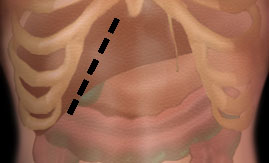Type of Incisions: Subcostal (Kocher)
Contributed by Mika Sinanan, MD
and his staff at the University of Washington Medical School

![]()
![]() The subcostal, or Kocher incision is used for open biliary surgery,such as cholecystectomy. The Kocher incision is not to be confused with the Kocher Maneuver, which describes the mobilization of the second and third portion of the duodenum and the pancreatic head. The subcostal incision is also used for access to the liver for wedge resections; for the adrenal gland on either side; and the spleen if on the left side. When extended laterally on the right with the patient in a rotated position, the incision is used for portacaval shunts. The incision may be extended medially as an alternative to the upper midline incision.
The subcostal, or Kocher incision is used for open biliary surgery,such as cholecystectomy. The Kocher incision is not to be confused with the Kocher Maneuver, which describes the mobilization of the second and third portion of the duodenum and the pancreatic head. The subcostal incision is also used for access to the liver for wedge resections; for the adrenal gland on either side; and the spleen if on the left side. When extended laterally on the right with the patient in a rotated position, the incision is used for portacaval shunts. The incision may be extended medially as an alternative to the upper midline incision.
Bilateral subcostal incisions are used to access to liver for transplant and liver resections. The exposure is often helped with a vertical extension to the xyphoid. Specialized retractors such as the Olivier and some blades for the upper hand have been developed for this incision.
Procedure: The standard subcostal incision is made 1 to 2 finger breadths below the costal margin, to facilitate closure so that the incision line is not on or over the costal margin. The exposure requirements will determine the incision length. The incision should be sized at the smallest length possible while safely permitting an adequate procedure. The incision is closed in two or three layers; usually the inner two layers are closed with a running absorbable suture, and the outer layer (external oblique and anterior rectus fascia) with either running or absorbable suture.

The major advantage of the subcostal incision over the upper midline incision is greater lateral exposure and less pain. Upper midline incisions are very painful and restrict pulmonary function, particularly vital capacity, by about 50 percent. Pulmonary problems, especially in patients with a history of lung disease, prior pneumonia, emphysema, etc. are common after an upper midline incision, thus the subcostal incision is preferred by many surgeons. The disadvantage of the subcostal incision is that the operation takes longer, because there are more layers to close.
Generally, the subcostal incision heals well.
![]()
![]() Back to Incision Index
Back to Incision Index
Home | Welcome | Clinical Update | Managing Your Residency | Basic Science
Board Review | Opportunities | Links | Contributors | Contact Us
